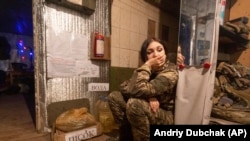On December 5, as Russian military forces massed along the border with Ukraine, Denis Pushilin, the head of the Russian-created puppet state known as the “Donetsk People’s Republic” (DNR), criticized the alarmed reactions sounding from Western powers.
"I consider these statements provocative, and even emanating not so much from Ukraine as from the United States, so all these insinuations which, it seems, must force Russia to withdraw troops from Russia, well, this is absurd,” Russia’s RIA Novosti state news agency quoted Pushilin as saying.
That is misleading. Russia’s deployment of as many as 175,000 military personnel and their equipment to its border with Ukraine has been well-documented. And Russia has taken over parts of Ukraine before, absorbing the Crimean Peninsula in 2014.
RIA Novosti also quoted Kremlin spokesman Dmitry Peskov, who said that Russia was merely moving its troops within its own territory, as its sovereignty and discretion allow.
But while Russia proclaims no threat, history and the buildup itself are reasonable cause for alarm, making Pushilin's statement misleading.
First, there is the history: Russia has already invaded Ukraine Pushilin’s “DNR,” along with its neighboring “Luhansk People’s Republic” (LNR), were both created by Russian military intervention.
In August 2014, the two secessionist states were on the verge of defeat thanks to a renewed Ukrainian military offensive. Russia saved its proxies by sending regular military forces across the border and shelling Ukrainian forces from Russian territory.
Russian military forces intervened directly again in early 2015, seizing the vital railway junction of Debaltseve despite a ceasefire stipulated by the Minsk II peace agreement. To support the puppet states materially, the Russian military has maintained bases and troops near the border with Ukraine.
In April, large numbers of Russian troops also were deployed along Ukraine’s borders. And in September, an estimated 200,000 Russian and Belarusian troops took part in the Zapad 2021 military exercise.
But the new buildup of troops is something different. Russian security experts have noted the lack of any scheduled major exercises that could explain it.
Russian forces have been observed transporting fuel and ammunition while creating forward bases to store the material, which would be crucial for any kind of invasion.
Command-and-control structures and field hospitals have also been set up. The evidence of this comes both from open-source material, such as videos posted on social media, and satellite photos showing the units deployed in their base camps.
Although some still doubt Russia plans a full-scale invasion, there is a growing consensus among Western military experts that the buildup is not a bluff and that some military action is being planned.
Although the Kremlin has repeatedly denied plans for new aggression, it has not denied the presence or troops as Pushilin did. At the same time, Russia has demanded U.S. “assurances” that Ukraine will not be allowed to join NATO.
Speaking on the day of a scheduled video conference between U.S. President Joe Biden and Russian President Vladimir Putin, Peskov again denied that Russia planned to attack anyone but added that, “We have our own red lines.”
Peskov’s implication that Russia is responding to “red lines” being crossed is ironic, since Russia already attacked Ukraine and the prospect of Ukrainian-NATO military cooperation was a direct response to that attack.
On December 7, Biden and Putin conducted their video conference call of about two hours. According to the White House, Biden warned Putin the United States and its allies would respond with “strong economic and other measures in the event of a military escalation.”
The Kremlin’s version of the call misleadingly referred to the war in Donbas as an “intra-Ukrainian” conflict and argued against “shifting responsibility on Russia” for the conflict, blaming NATO instead.
The conflict, however, was initiated by Russia, and Ukraine was not seeking NATO membership in 2014 when the fighting started. Since then, the war has reportedly claimed more than 13,000 civilian and military casualties, although estimates vary.





